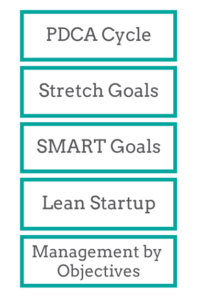by Jurgen Appelo
OKRs are a mix of the PDCA cycle, stretch goals, SMART goals, the Lean Startup method and Management by Objectives. Basically, it’s all of them wrapped up in one agile management practice.
So many metrics, so little time. The lyrics of the actual song, one of my favorites from the 80s, were a bit different, but the conclusion remains the same: we must make choices. Both in our personal and work life.
For this reason, I started experimenting with OKRs about six months ago. This ugly term is an acronym for Objectives and Key Results; an increasingly popular practice, commonly associated with Google.

For anyone familiar with the Plan-Do-Check-Act (PDCA) cycle or the Build-Measure-Learn cycle of Lean Startup, the OKR’s practice makes perfect sense. It’s yet another feedback loop, only this one is oriented toward personal improvement. We could redefine it as Objective-Targets-Evaluation.
The Objective is a qualitative goal that you set yourself for the next few months. For example, ‘Be a faster runner’, ‘Launch a successful website’, or ‘Sell more books’. You can have several such objectives, but the point is to focus. Less is more! Each objective should be ambitious and feel a bit uncomfortable. You must feel like, “Gosh, I don’t know if I’m able to do this.” Because, if you don’t aim high, you won’t rise fast. That’s why some people refer to such objectives as stretch goals.
The ‘Targets’ (in Google’s terminology: key results) are there to make your objective measurable. There’s no point setting yourself objectives if you cannot measure progress and if you cannot determine whether you succeeded. That’s why some people traditionally refer to key results as SMART goals: Specific, Measurable, Achievable, Realistic and Time-bound.
The twist that the OKR’s practice adds is that you must define multiple key results. That’s because no metric is perfect, and it’s best to look at each problem from multiple angles. Don’t get all hung up over one silly target. If one target fails, no worries! You have others.
The final part of the OKR’s practice is the Evaluation or self-assessment. Or to speak in terms of the Lean Startup method, at the end if the cycle: what did you learn? It’s interesting to note that traditional organizations usually go wrong with this step. Most of the time, managers use metrics to evaluate other people, not themselves.
But this is not at all what Peter Drucker intended when he offered Management by Objectives several decades ago. He suggested that managers, like all other professionals, should measure themselves. The OKR’s practice makes this even more explicit by telling people to rate their own outcomes, for each of their targets, on a scale of 0% to 100%, and then to calculate the average.
Example:
One of my team’s objectives for Q1 is to scale up Management 3.0 licensing (= objective). As targets, I came up with the following metrics:
- 20 new inquiries between Mar 14-28 via new website (from 2)
- 125 licensed facilitators (now 102)
- 30 events scheduled per month (now 20)
Each of these three goals is measurable, and we’re going to evaluate ourselves on March 31, earning a score between 0% to 100% for each of the three targets.
As Google says about OKRs, the purpose of this practice is not to achieve an average score of 100% for each of your objectives. If you do, your objectives are probably too easy! Instead, the purpose is to do worse than 100% (maybe even fail completely) and then learn what you can do better next time. The purpose is self-improvement, not a self-compliment.
The OKRs practice is like the Mojito Method applied to PDCA, stretch goals, SMART goals, Lean Startup and Management by Objectives. It’s all of them wrapped in one simple-to-implement (but hard-to-do) modern management practice!
Do you want to learn more? Attend a Management 3.0 Workshop and discuss many modern management practices, with like-minded people.

